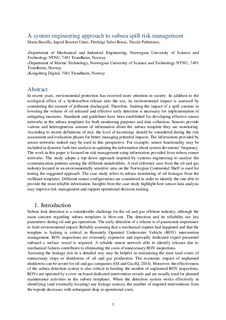| dc.contributor.author | Bucelli, Marta | |
| dc.contributor.author | Utne, Ingrid Bouwer | |
| dc.contributor.author | Salvo Rossi, Pierluigi | |
| dc.contributor.author | Paltrinieri, Nicola | |
| dc.date.accessioned | 2020-03-17T14:41:30Z | |
| dc.date.available | 2020-03-17T14:41:30Z | |
| dc.date.created | 2020-02-28T15:02:15Z | |
| dc.date.issued | 2020 | |
| dc.identifier.issn | 0925-7535 | |
| dc.identifier.uri | http://hdl.handle.net/11250/2647246 | |
| dc.description.abstract | In recent years, environmental protection has received more attention in society. In addition to the ecological effect of a hydrocarbon release into the sea, its environmental impact is assessed by considering the amount of pollutant discharged. Therefore, limiting the impact of a spill consists in lowering the volume of oil released and effective early detection is necessary for implementation of mitigating measures. Standards and guidelines have been established for developing effective sensor networks in the subsea templates for both monitoring purposes and data collection. Sensors provide various and heterogeneous amount of information about the subsea template they are monitoring. According to recent definitions of risk, the level of knowledge should be considered during the risk assessment and evaluation phases for better managing potential impacts. The information provided by sensor networks indeed may be used in this perspective. For example, sensor functionality may be included in dynamic fault tree analysis in updating the information about system deviations’ frequency.
The work in this paper is focused on risk management using information provided from subsea sensor networks. The study adopts a top-down approach inspired by systems engineering to analyse the communication patterns among the different stakeholders. A real reference case from the oil and gas industry located in an environmentally sensitive area on the Norwegian Continental Shelf is used for testing the suggested approach. The case study refers to subsea monitoring of oil leakages from the wellhead templates. Different sensor configurations are considered in order to identify the one able to provide the most reliable information. Insights from the case study highlight how sensor data analysis may improve risk management and support operational decision making. | nb_NO |
| dc.language.iso | eng | nb_NO |
| dc.publisher | Elsevier | nb_NO |
| dc.rights | Attribution-NonCommercial-NoDerivatives 4.0 Internasjonal | * |
| dc.rights.uri | http://creativecommons.org/licenses/by-nc-nd/4.0/deed.no | * |
| dc.title | A system engineering approach to subsea spill risk management | nb_NO |
| dc.type | Journal article | nb_NO |
| dc.type | Peer reviewed | nb_NO |
| dc.description.version | acceptedVersion | nb_NO |
| dc.source.journal | Safety Science | nb_NO |
| dc.identifier.doi | 10.1016/j.ssci.2019.104560 | |
| dc.identifier.cristin | 1798508 | |
| dc.description.localcode | © 2020. This is the authors’ accepted and refereed manuscript to the article. Locked until 10.12.2022 due to copyright restrictions. This manuscript version is made available under the CC-BY-NC-ND 4.0 license http://creativecommons.org/licenses/by-nc-nd/4.0/ | nb_NO |
| cristin.unitcode | 194,64,92,0 | |
| cristin.unitcode | 194,64,20,0 | |
| cristin.unitcode | 194,63,35,0 | |
| cristin.unitname | Institutt for maskinteknikk og produksjon | |
| cristin.unitname | Institutt for marin teknikk | |
| cristin.unitname | Institutt for elektroniske systemer | |
| cristin.ispublished | true | |
| cristin.fulltext | postprint | |
| cristin.qualitycode | 1 | |

